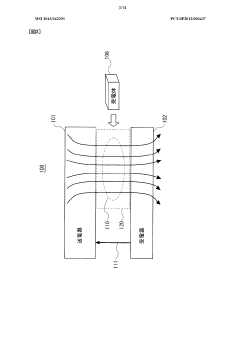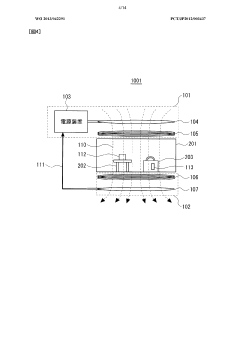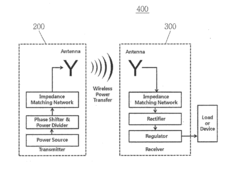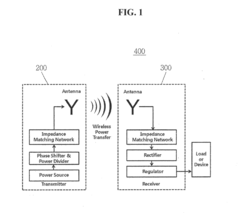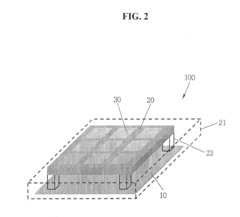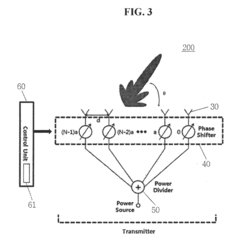Potential of Electromagnetic Waves in Wireless Power Transfer
JUL 11, 202510 MIN READ
Generate Your Research Report Instantly with AI Agent
Patsnap Eureka helps you evaluate technical feasibility & market potential.
WPT Technology Background and Objectives
Wireless Power Transfer (WPT) technology has emerged as a revolutionary concept in the field of energy transmission, leveraging the potential of electromagnetic waves to transmit power without the need for physical connections. The development of WPT can be traced back to the late 19th century when Nikola Tesla first demonstrated the possibility of wireless energy transfer. However, it is only in recent decades that significant advancements have been made in this domain, driven by the increasing demand for convenient and efficient power delivery solutions.
The evolution of WPT technology has been closely tied to the progress in electromagnetic theory, power electronics, and materials science. Early experiments focused on near-field coupling techniques, which were limited in range and efficiency. As research progressed, far-field methods utilizing radio frequency (RF) and microwave technologies began to show promise for longer-range power transmission. This shift opened up new possibilities for applications in various sectors, including consumer electronics, automotive, healthcare, and industrial automation.
The primary objective of WPT technology is to achieve efficient, safe, and reliable power transfer over varying distances without the constraints of wired connections. This goal encompasses several key aspects, including maximizing power transfer efficiency, minimizing electromagnetic interference, ensuring safety for users and surrounding environments, and developing scalable solutions for different power requirements and applications.
Current research in WPT is focused on overcoming several technical challenges. These include improving the overall system efficiency, extending the transmission range, enhancing power density, and developing adaptive systems that can optimize power transfer in dynamic environments. Additionally, there is a growing emphasis on integrating WPT with existing infrastructure and emerging technologies such as 5G networks and Internet of Things (IoT) devices.
The potential applications of WPT technology are vast and continue to expand. In the consumer electronics sector, wireless charging for smartphones and other portable devices has already gained significant traction. The automotive industry is exploring WPT for electric vehicle charging, both stationary and dynamic. In healthcare, WPT holds promise for powering implantable medical devices without invasive procedures. Industrial applications include wireless power for sensors and actuators in hard-to-reach locations or hazardous environments.
As WPT technology advances, it is expected to play a crucial role in shaping the future of energy distribution and consumption. The vision is to create a world where power can be delivered seamlessly and ubiquitously, much like how data is transmitted wirelessly today. This paradigm shift could lead to significant changes in how we design and interact with electronic devices, vehicles, and infrastructure, potentially revolutionizing multiple industries and aspects of daily life.
The evolution of WPT technology has been closely tied to the progress in electromagnetic theory, power electronics, and materials science. Early experiments focused on near-field coupling techniques, which were limited in range and efficiency. As research progressed, far-field methods utilizing radio frequency (RF) and microwave technologies began to show promise for longer-range power transmission. This shift opened up new possibilities for applications in various sectors, including consumer electronics, automotive, healthcare, and industrial automation.
The primary objective of WPT technology is to achieve efficient, safe, and reliable power transfer over varying distances without the constraints of wired connections. This goal encompasses several key aspects, including maximizing power transfer efficiency, minimizing electromagnetic interference, ensuring safety for users and surrounding environments, and developing scalable solutions for different power requirements and applications.
Current research in WPT is focused on overcoming several technical challenges. These include improving the overall system efficiency, extending the transmission range, enhancing power density, and developing adaptive systems that can optimize power transfer in dynamic environments. Additionally, there is a growing emphasis on integrating WPT with existing infrastructure and emerging technologies such as 5G networks and Internet of Things (IoT) devices.
The potential applications of WPT technology are vast and continue to expand. In the consumer electronics sector, wireless charging for smartphones and other portable devices has already gained significant traction. The automotive industry is exploring WPT for electric vehicle charging, both stationary and dynamic. In healthcare, WPT holds promise for powering implantable medical devices without invasive procedures. Industrial applications include wireless power for sensors and actuators in hard-to-reach locations or hazardous environments.
As WPT technology advances, it is expected to play a crucial role in shaping the future of energy distribution and consumption. The vision is to create a world where power can be delivered seamlessly and ubiquitously, much like how data is transmitted wirelessly today. This paradigm shift could lead to significant changes in how we design and interact with electronic devices, vehicles, and infrastructure, potentially revolutionizing multiple industries and aspects of daily life.
Market Demand for Wireless Charging Solutions
The market demand for wireless charging solutions has been experiencing significant growth in recent years, driven by the increasing adoption of portable electronic devices and the growing need for convenient and efficient charging methods. This trend is particularly evident in consumer electronics, automotive, and industrial sectors.
In the consumer electronics market, smartphones, tablets, and wearable devices are the primary drivers of wireless charging demand. As these devices become more prevalent in daily life, consumers are seeking seamless and hassle-free charging solutions. Major smartphone manufacturers have integrated wireless charging capabilities into their flagship models, further fueling market growth. The convenience factor of simply placing a device on a charging pad without the need for cables has resonated strongly with consumers.
The automotive industry has also embraced wireless charging technology, with many car manufacturers incorporating wireless charging pads into their vehicle designs. This feature is particularly appealing for electric and hybrid vehicles, where efficient charging is crucial. The integration of wireless charging in cars not only enhances user experience but also aligns with the broader trend of vehicle electrification.
In the industrial sector, wireless charging solutions are gaining traction for applications in manufacturing, warehousing, and logistics. The ability to charge equipment and devices without physical connections improves operational efficiency and reduces downtime associated with traditional charging methods. This is especially valuable in environments where mobility and flexibility are essential.
The healthcare industry is another sector showing increased interest in wireless charging solutions. Medical devices, patient monitoring equipment, and wearable health trackers benefit from the convenience and improved hygiene offered by contactless charging. This trend is likely to accelerate as healthcare facilities prioritize infection control and streamlined operations.
Market research indicates a robust growth trajectory for the wireless charging market. The global wireless charging market size is projected to expand significantly over the next few years, with compound annual growth rates (CAGR) in double digits. This growth is attributed to technological advancements, increasing investment in research and development, and the expanding ecosystem of compatible devices.
Consumer surveys reveal a strong preference for wireless charging options, with many users citing convenience and reduced cable clutter as key benefits. This consumer sentiment is driving manufacturers to incorporate wireless charging capabilities across a wider range of products, further expanding the market.
As the technology continues to evolve, addressing challenges such as charging efficiency, distance limitations, and compatibility across different devices will be crucial for sustained market growth. The development of more advanced wireless power transfer technologies, including those utilizing electromagnetic waves, holds the potential to overcome current limitations and open up new applications and market opportunities.
In the consumer electronics market, smartphones, tablets, and wearable devices are the primary drivers of wireless charging demand. As these devices become more prevalent in daily life, consumers are seeking seamless and hassle-free charging solutions. Major smartphone manufacturers have integrated wireless charging capabilities into their flagship models, further fueling market growth. The convenience factor of simply placing a device on a charging pad without the need for cables has resonated strongly with consumers.
The automotive industry has also embraced wireless charging technology, with many car manufacturers incorporating wireless charging pads into their vehicle designs. This feature is particularly appealing for electric and hybrid vehicles, where efficient charging is crucial. The integration of wireless charging in cars not only enhances user experience but also aligns with the broader trend of vehicle electrification.
In the industrial sector, wireless charging solutions are gaining traction for applications in manufacturing, warehousing, and logistics. The ability to charge equipment and devices without physical connections improves operational efficiency and reduces downtime associated with traditional charging methods. This is especially valuable in environments where mobility and flexibility are essential.
The healthcare industry is another sector showing increased interest in wireless charging solutions. Medical devices, patient monitoring equipment, and wearable health trackers benefit from the convenience and improved hygiene offered by contactless charging. This trend is likely to accelerate as healthcare facilities prioritize infection control and streamlined operations.
Market research indicates a robust growth trajectory for the wireless charging market. The global wireless charging market size is projected to expand significantly over the next few years, with compound annual growth rates (CAGR) in double digits. This growth is attributed to technological advancements, increasing investment in research and development, and the expanding ecosystem of compatible devices.
Consumer surveys reveal a strong preference for wireless charging options, with many users citing convenience and reduced cable clutter as key benefits. This consumer sentiment is driving manufacturers to incorporate wireless charging capabilities across a wider range of products, further expanding the market.
As the technology continues to evolve, addressing challenges such as charging efficiency, distance limitations, and compatibility across different devices will be crucial for sustained market growth. The development of more advanced wireless power transfer technologies, including those utilizing electromagnetic waves, holds the potential to overcome current limitations and open up new applications and market opportunities.
Current State and Challenges in EM Wave-based WPT
Electromagnetic wave-based wireless power transfer (WPT) has made significant strides in recent years, yet it still faces numerous challenges that hinder its widespread adoption. The current state of this technology is characterized by a mix of promising advancements and persistent limitations.
One of the primary challenges in EM wave-based WPT is the issue of efficiency. While near-field WPT systems have achieved relatively high efficiency rates, far-field systems struggle to maintain comparable performance. The efficiency of power transfer decreases rapidly with distance due to the inverse square law, making it difficult to transmit significant amounts of power over long distances without substantial losses.
Another major hurdle is the problem of directionality. EM wave-based WPT systems often require precise alignment between the transmitter and receiver to achieve optimal power transfer. This limitation restricts the mobility and flexibility of devices that rely on wireless charging, as they must maintain a specific orientation or position relative to the power source.
Safety concerns also pose significant challenges to the widespread implementation of EM wave-based WPT. The potential health effects of prolonged exposure to electromagnetic radiation, particularly at higher power levels, remain a topic of ongoing research and debate. Regulatory bodies have imposed strict limits on the amount of electromagnetic energy that can be safely transmitted, which in turn constrains the practical applications of this technology.
The issue of interference with existing wireless communication systems is another critical challenge. EM wave-based WPT operates in frequency bands that may overlap with those used for various communication technologies, potentially causing disruptions to essential services. Developing systems that can coexist harmoniously with existing wireless infrastructure without causing interference is a complex technical challenge.
Miniaturization of WPT components, particularly for mobile and wearable devices, remains an ongoing challenge. The size and weight of current WPT systems can be prohibitive for many applications, necessitating further research into more compact and efficient designs.
Despite these challenges, the field of EM wave-based WPT has seen notable advancements. Researchers have made progress in developing more efficient antennas and rectifying circuits, improving power management systems, and exploring novel materials to enhance overall system performance. Additionally, adaptive beamforming techniques and intelligent power management algorithms are being developed to address issues of directionality and efficiency.
The current state of EM wave-based WPT technology varies significantly across different geographical regions. Countries like South Korea, Japan, and the United States are at the forefront of research and development in this field, with several companies and research institutions actively working on overcoming the existing challenges. However, the global landscape of WPT technology development is rapidly evolving, with emerging players from China and Europe making significant contributions to the field.
One of the primary challenges in EM wave-based WPT is the issue of efficiency. While near-field WPT systems have achieved relatively high efficiency rates, far-field systems struggle to maintain comparable performance. The efficiency of power transfer decreases rapidly with distance due to the inverse square law, making it difficult to transmit significant amounts of power over long distances without substantial losses.
Another major hurdle is the problem of directionality. EM wave-based WPT systems often require precise alignment between the transmitter and receiver to achieve optimal power transfer. This limitation restricts the mobility and flexibility of devices that rely on wireless charging, as they must maintain a specific orientation or position relative to the power source.
Safety concerns also pose significant challenges to the widespread implementation of EM wave-based WPT. The potential health effects of prolonged exposure to electromagnetic radiation, particularly at higher power levels, remain a topic of ongoing research and debate. Regulatory bodies have imposed strict limits on the amount of electromagnetic energy that can be safely transmitted, which in turn constrains the practical applications of this technology.
The issue of interference with existing wireless communication systems is another critical challenge. EM wave-based WPT operates in frequency bands that may overlap with those used for various communication technologies, potentially causing disruptions to essential services. Developing systems that can coexist harmoniously with existing wireless infrastructure without causing interference is a complex technical challenge.
Miniaturization of WPT components, particularly for mobile and wearable devices, remains an ongoing challenge. The size and weight of current WPT systems can be prohibitive for many applications, necessitating further research into more compact and efficient designs.
Despite these challenges, the field of EM wave-based WPT has seen notable advancements. Researchers have made progress in developing more efficient antennas and rectifying circuits, improving power management systems, and exploring novel materials to enhance overall system performance. Additionally, adaptive beamforming techniques and intelligent power management algorithms are being developed to address issues of directionality and efficiency.
The current state of EM wave-based WPT technology varies significantly across different geographical regions. Countries like South Korea, Japan, and the United States are at the forefront of research and development in this field, with several companies and research institutions actively working on overcoming the existing challenges. However, the global landscape of WPT technology development is rapidly evolving, with emerging players from China and Europe making significant contributions to the field.
Existing EM Wave WPT Solutions and Implementations
01 Resonant coupling for efficient power transfer
Resonant coupling techniques are used to enhance the efficiency of electromagnetic wave power transfer. This method involves tuning the transmitting and receiving coils to the same resonant frequency, allowing for efficient energy transfer over longer distances with reduced power loss.- Resonant coupling for efficient power transfer: Resonant coupling techniques are used to enhance power transfer efficiency in electromagnetic wave systems. This method involves tuning the transmitter and receiver to the same resonant frequency, allowing for efficient energy transfer over longer distances with minimal losses.
- Adaptive power control and impedance matching: Implementing adaptive power control and impedance matching mechanisms can significantly improve power transfer efficiency. These systems dynamically adjust power levels and match impedances between transmitter and receiver to optimize energy transfer under varying conditions.
- Beamforming and directional antennas: Utilizing beamforming techniques and directional antennas can focus electromagnetic waves in specific directions, increasing power transfer efficiency by minimizing energy dispersion. This approach is particularly effective for long-distance power transmission.
- Metamaterials and electromagnetic field shaping: Incorporating metamaterials and electromagnetic field shaping techniques can enhance power transfer efficiency by manipulating the propagation of electromagnetic waves. These advanced materials and methods can create more favorable conditions for energy transmission and reception.
- Multi-frequency and broadband power transfer: Developing multi-frequency and broadband power transfer systems can improve overall efficiency by utilizing a wider range of electromagnetic spectrum. This approach allows for more flexible and robust power transmission across various environmental conditions and distances.
02 Adaptive power control systems
Adaptive power control systems are implemented to optimize power transfer efficiency by adjusting the transmitted power based on the receiver's needs and environmental conditions. These systems use feedback mechanisms to maintain optimal power levels and minimize energy waste.Expand Specific Solutions03 Metamaterial-based power transfer
Metamaterials are engineered structures with unique electromagnetic properties that can be used to enhance power transfer efficiency. These materials can manipulate electromagnetic waves to focus energy, reduce losses, and improve overall system performance in wireless power transfer applications.Expand Specific Solutions04 Beamforming and directional power transfer
Beamforming techniques are employed to focus electromagnetic waves in specific directions, improving power transfer efficiency by concentrating energy towards the intended receiver. This approach reduces power loss and interference, particularly in long-range wireless power transfer scenarios.Expand Specific Solutions05 Impedance matching for optimal power transfer
Impedance matching techniques are used to maximize power transfer efficiency by ensuring that the source impedance matches the load impedance. This approach minimizes reflections and standing waves, allowing for optimal energy transfer between the transmitter and receiver in electromagnetic wave power systems.Expand Specific Solutions
Key Players in Wireless Charging Industry
The wireless power transfer market is in a growth phase, with increasing adoption across various industries. The market size is expanding rapidly, driven by the rising demand for convenient charging solutions. Technologically, the field is advancing, but still evolving towards widespread commercial viability. Key players like Energous Corp., QUALCOMM, Inc., and Samsung Electronics Co., Ltd. are leading innovation, developing more efficient and longer-range solutions. Companies such as WiTricity Corp. and Ossia, Inc. are focusing on specific applications like electric vehicle charging and IoT devices. Academic institutions like Harbin Institute of Technology and Rice University are contributing to fundamental research, pushing the boundaries of electromagnetic wave utilization in power transfer.
Energous Corp.
Technical Solution: Energous has developed WattUp, a revolutionary RF-based wireless charging technology. WattUp uses a transmitter that sends focused beams of RF energy to receiver devices, enabling charging at a distance of up to 15 feet[1]. The system employs sophisticated software algorithms and antenna designs to form pockets of energy that can charge multiple devices simultaneously. Energous has also introduced WattUp PowerBridge, a transmitter capable of charging electronic devices over the air within a 1-meter range, demonstrating continuous progress in expanding charging distances[2].
Strengths: Long-range charging capability, multi-device support, and FCC approval for certain products. Weaknesses: Limited power delivery for long-range applications and potential interference with other wireless devices.
QUALCOMM, Inc.
Technical Solution: Qualcomm has developed its proprietary wireless power transfer technology called WiPower. This near-field magnetic resonance technology allows for spatial freedom in device placement and can charge multiple devices simultaneously. WiPower operates at a frequency of 6.78 MHz, enabling efficient power transfer through various materials[3]. Qualcomm has also been working on integrating wireless charging capabilities into its mobile platforms, potentially allowing smartphones to double as charging pads for other devices[4]. The company is actively involved in developing standards for resonant wireless power transfer through its participation in the AirFuel Alliance.
Strengths: Integration with mobile platforms, established presence in the wireless industry, and involvement in standardization efforts. Weaknesses: Limited commercial deployment of WiPower technology and competition from other established wireless charging standards.
Core Innovations in EM Wave-based Wireless Charging
Wireless power feeding system and wireless power feeding method
PatentWO2013042291A1
Innovation
- A wireless power supply system that uses electromagnetic waves to create a resonance phenomenon between a power transmitter and receiver, allowing for long-distance and efficient power transmission by separating the electromagnetic field forming function from the power receiving function, enabling power reception through electromagnetic induction regardless of the receiver's position or resonance frequency matching.
Electromagnetic wave radiation-based wireless power transmitter and wireless power transfer system using high gain antenna and beam forming and steering technology
PatentInactiveUS20170187250A1
Innovation
- A wireless power transmitter system utilizing a high gain wireless power transmitting antenna with a ground layer, dielectric layer, and radiation patches, combined with phase shifters and a control unit for beam forming and steering, which adjusts the radiation direction and phase of electromagnetic waves to enhance efficiency and safety by concentrating energy beams.
Electromagnetic Safety and Regulatory Considerations
The implementation of wireless power transfer (WPT) using electromagnetic waves raises significant safety and regulatory concerns that must be addressed to ensure widespread adoption and public acceptance. One of the primary considerations is the potential health effects of prolonged exposure to electromagnetic fields (EMF) generated by WPT systems. Regulatory bodies worldwide have established guidelines and standards to limit human exposure to EMF, with organizations such as the International Commission on Non-Ionizing Radiation Protection (ICNIRP) providing recommendations for safe exposure levels.
These guidelines typically set limits on the specific absorption rate (SAR) of electromagnetic energy by human tissue, as well as maximum permissible exposure levels for different frequency ranges. WPT system designers must carefully consider these limits when developing their technologies, ensuring that the emitted electromagnetic fields fall within acceptable ranges. This often involves implementing shielding techniques, optimizing power transfer efficiency to minimize stray fields, and incorporating safety features that can detect the presence of humans or animals in the vicinity of the WPT system.
In addition to health concerns, electromagnetic compatibility (EMC) is another crucial regulatory aspect. WPT systems must not interfere with other electronic devices or communication systems operating in the same environment. This requires adherence to EMC standards set by organizations such as the International Electrotechnical Commission (IEC) and the Federal Communications Commission (FCC). Compliance with these standards often necessitates the use of frequency selection techniques, power control mechanisms, and advanced modulation schemes to minimize electromagnetic interference.
The regulatory landscape for WPT technologies is still evolving, with different countries and regions developing their own specific requirements. For instance, the European Union has been working on harmonized standards for WPT systems under the Radio Equipment Directive (RED), while the United States relies on FCC regulations for wireless power devices. As the technology advances, it is likely that new standards and regulations will emerge to address specific applications and power levels of WPT systems.
Manufacturers and developers of WPT technologies must navigate this complex regulatory environment, ensuring compliance with both safety and EMC requirements. This often involves extensive testing and certification processes, which can be time-consuming and costly. However, these measures are essential for building public trust and ensuring the safe integration of WPT systems into everyday life. As the technology continues to evolve, ongoing collaboration between industry stakeholders, regulatory bodies, and research institutions will be crucial in refining safety standards and addressing emerging concerns related to electromagnetic waves in wireless power transfer.
These guidelines typically set limits on the specific absorption rate (SAR) of electromagnetic energy by human tissue, as well as maximum permissible exposure levels for different frequency ranges. WPT system designers must carefully consider these limits when developing their technologies, ensuring that the emitted electromagnetic fields fall within acceptable ranges. This often involves implementing shielding techniques, optimizing power transfer efficiency to minimize stray fields, and incorporating safety features that can detect the presence of humans or animals in the vicinity of the WPT system.
In addition to health concerns, electromagnetic compatibility (EMC) is another crucial regulatory aspect. WPT systems must not interfere with other electronic devices or communication systems operating in the same environment. This requires adherence to EMC standards set by organizations such as the International Electrotechnical Commission (IEC) and the Federal Communications Commission (FCC). Compliance with these standards often necessitates the use of frequency selection techniques, power control mechanisms, and advanced modulation schemes to minimize electromagnetic interference.
The regulatory landscape for WPT technologies is still evolving, with different countries and regions developing their own specific requirements. For instance, the European Union has been working on harmonized standards for WPT systems under the Radio Equipment Directive (RED), while the United States relies on FCC regulations for wireless power devices. As the technology advances, it is likely that new standards and regulations will emerge to address specific applications and power levels of WPT systems.
Manufacturers and developers of WPT technologies must navigate this complex regulatory environment, ensuring compliance with both safety and EMC requirements. This often involves extensive testing and certification processes, which can be time-consuming and costly. However, these measures are essential for building public trust and ensuring the safe integration of WPT systems into everyday life. As the technology continues to evolve, ongoing collaboration between industry stakeholders, regulatory bodies, and research institutions will be crucial in refining safety standards and addressing emerging concerns related to electromagnetic waves in wireless power transfer.
Energy Efficiency and Environmental Impact of WPT
Wireless Power Transfer (WPT) technology, while promising, raises important questions about energy efficiency and environmental impact. The efficiency of WPT systems is a critical factor in their widespread adoption and sustainability. Current WPT systems typically achieve efficiencies ranging from 70% to 90%, depending on the specific technology and application. However, these figures are often achieved under ideal laboratory conditions and may not reflect real-world performance.
One of the main challenges in improving WPT efficiency is minimizing power loss during transmission. This loss occurs due to factors such as electromagnetic interference, impedance mismatching, and conversion losses in both transmitting and receiving circuits. Researchers are exploring various techniques to address these issues, including adaptive impedance matching, resonant coupling, and beamforming technologies.
From an environmental perspective, WPT systems have the potential to reduce the need for disposable batteries, thereby decreasing electronic waste. This could lead to significant environmental benefits, particularly in applications such as consumer electronics and electric vehicles. However, the increased electromagnetic radiation associated with WPT raises concerns about potential health effects and interference with other electronic devices.
The environmental impact of WPT also extends to its energy source. If the power for WPT systems is derived from renewable sources, it could contribute to a reduction in greenhouse gas emissions. Conversely, if the power comes from fossil fuel-based sources, the overall environmental benefit may be diminished.
Another consideration is the lifecycle analysis of WPT systems. While they may reduce battery waste, the production and eventual disposal of WPT components also have environmental implications. The use of rare earth elements in some WPT systems, for instance, raises questions about resource depletion and the environmental impact of mining activities.
Efforts to improve the energy efficiency of WPT systems are ongoing. These include the development of more efficient power conversion circuits, the use of advanced materials for coils and shielding, and the implementation of smart power management systems. Some researchers are also exploring the integration of WPT with energy harvesting technologies to create self-sustaining power transfer ecosystems.
As WPT technology continues to evolve, it is crucial to balance the potential benefits with environmental considerations. This includes not only improving the efficiency of power transfer but also addressing concerns about electromagnetic radiation, resource use, and end-of-life disposal. Regulatory bodies and industry standards will play a key role in ensuring that WPT technologies are developed and deployed in an environmentally responsible manner.
One of the main challenges in improving WPT efficiency is minimizing power loss during transmission. This loss occurs due to factors such as electromagnetic interference, impedance mismatching, and conversion losses in both transmitting and receiving circuits. Researchers are exploring various techniques to address these issues, including adaptive impedance matching, resonant coupling, and beamforming technologies.
From an environmental perspective, WPT systems have the potential to reduce the need for disposable batteries, thereby decreasing electronic waste. This could lead to significant environmental benefits, particularly in applications such as consumer electronics and electric vehicles. However, the increased electromagnetic radiation associated with WPT raises concerns about potential health effects and interference with other electronic devices.
The environmental impact of WPT also extends to its energy source. If the power for WPT systems is derived from renewable sources, it could contribute to a reduction in greenhouse gas emissions. Conversely, if the power comes from fossil fuel-based sources, the overall environmental benefit may be diminished.
Another consideration is the lifecycle analysis of WPT systems. While they may reduce battery waste, the production and eventual disposal of WPT components also have environmental implications. The use of rare earth elements in some WPT systems, for instance, raises questions about resource depletion and the environmental impact of mining activities.
Efforts to improve the energy efficiency of WPT systems are ongoing. These include the development of more efficient power conversion circuits, the use of advanced materials for coils and shielding, and the implementation of smart power management systems. Some researchers are also exploring the integration of WPT with energy harvesting technologies to create self-sustaining power transfer ecosystems.
As WPT technology continues to evolve, it is crucial to balance the potential benefits with environmental considerations. This includes not only improving the efficiency of power transfer but also addressing concerns about electromagnetic radiation, resource use, and end-of-life disposal. Regulatory bodies and industry standards will play a key role in ensuring that WPT technologies are developed and deployed in an environmentally responsible manner.
Unlock deeper insights with Patsnap Eureka Quick Research — get a full tech report to explore trends and direct your research. Try now!
Generate Your Research Report Instantly with AI Agent
Supercharge your innovation with Patsnap Eureka AI Agent Platform!


